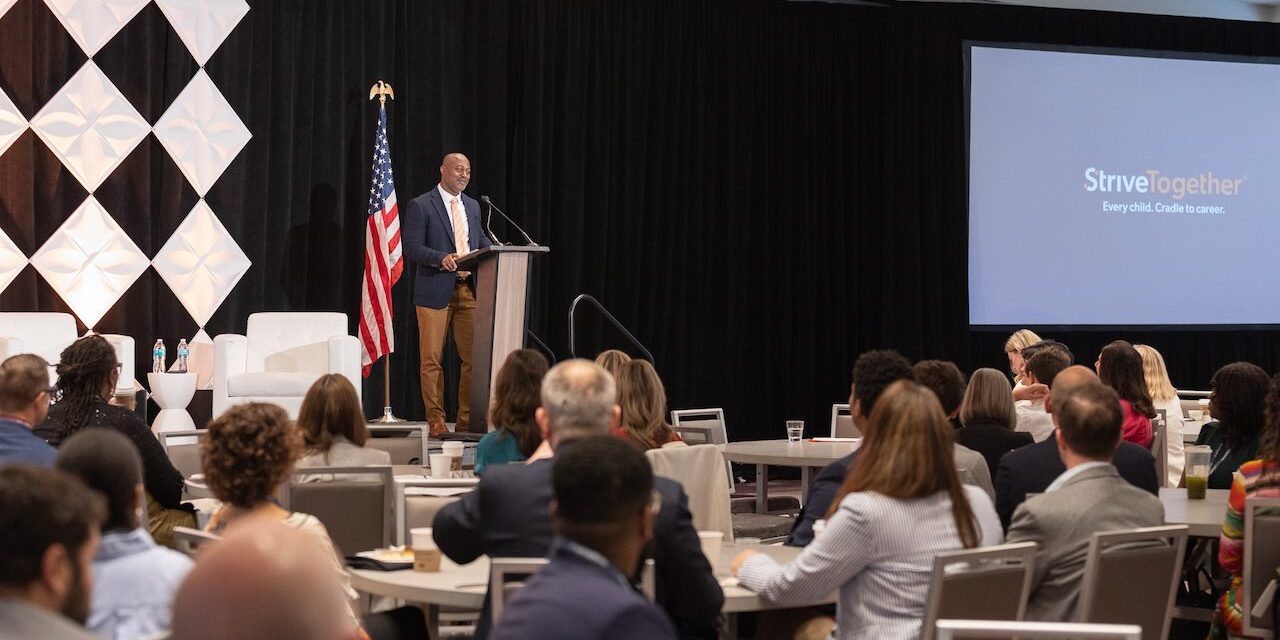Effective policy takes root in the realities of place. When communities lead, policy becomes a pathway to real, measurable change. At the 2025 Policy Summit in Washington, D.C., more than 160 Cradle to Career Network members and national partners came together to reflect, strategize and move forward. Fueled by a shared commitment to implementation, opportunity and local leadership, we’re turning bold ideas into outcomes that improve lives.
This year’s summit focused on the power of community leadership. Local partnerships are turning policy into practice, from early childhood investments to workforce strategies. By grounding decisions in local context and collaboration, communities are transforming legislation into measurable impact. The summit affirmed that real change starts with those closest to the work.
Several themes came into focus as we heard from communities and national experts:
Ground implementation in local data, alignment and partnerships
Local leaders are using federal tools to meet regional workforce needs. We saw this during the summit’s sessions on youth apprenticeship, school-to-work transitions and key federal policies like the Workforce Innovation and Opportunity Act (WIOA). In communities like Memphis, Tennessee, and eastern Connecticut, WIOA funds are supporting youth apprenticeships and building career pathways that reflect local labor market data. These communities are designing solutions that respond directly to the needs of young people and the wants of employers.
Other states are embedding evidence into resource allocation in ways that increase both transparency and impact. In Texas, grant applications are scored based on the strength of supporting evidence. In Ohio, performance-based contracts link provider funding to outcomes like credential attainment and employment while regional partnerships align education, workforce development and community support to expand economic mobility statewide. These strategies help ensure that investments bring tangible results.
Kara Conroy, senior researcher at Mathematica, explained how regional workforce boards are partnering with school districts and employers to track real-time data on credential completion and job placement. She also highlighted the value of wraparound services, coaching and milestone-based incentives in keeping youth engaged.
Strengthen systems through early investment
At the summit, Dr. Keri Randolph, executive director at Chattanooga 2.0, reminded us, “We can’t wait until kids are in school to start thinking about outcomes. By then, we’ve already missed critical opportunities to support families and build a stronger foundation.” Her words emphasized how early investment plays a critical role in strengthening systems and improving long-term results for entire communities.
Federal programs like Temporary Assistance for Needy Families (TANF), Child Care and Development Block Grant (CCDBG) and Head Start can be leveraged to strengthen kindergarten readiness and long-term well-being. Place-based partnerships including Chattanooga 2.0 and the Minnesota Department of Early Learning are aligning funding streams with community priorities to build stronger early learning systems.
Support youth leadership as core infrastructure
The keynote panel featuring youth leaders made a lasting impact at the Policy Summit. Young leaders shared how they are already leading policy work in their communities, shaping policies and advocating for improvements. Their leadership is strategic and informed by lived experience, offering fresh and relevant perspectives.
Panelists emphasized the importance of adults offering meaningful support through mentorship and genuine partnership. Aislinn Seiler, a youth leader from Norwalk ACTS, voiced, “We need to be empowered to lead through the things we care about. That’s how leadership grows from passion and not from obligation.”
Maria Fernanda Cifuentes, a Cradle-to-Career Fellow at Harlem Children’s Zone, is showing leadership by creating a bilingual college resource guide shaped by her own experience of being discouraged from applying to elite institutions. The guide is now distributed at student and family events to help first-generation students access the tools and support she once lacked.
Cyrus Holt, a youth leader with Rocky Mountain Partnership, and Jeffrey Payne from Milwaukee Succeeds are advocating for improvements in school infrastructure and mental health resources. Jeffery also piloted a flexible tutoring session model at his school to support more individualized academic support.
In a room full of network members, youth leaders emphasized the value of being engaged at every stage of the policy process rather than brought in as an afterthought. Investing in youth leadership leads to more informed decisions, shifts power and cultivates the next generation of civic leaders who are already demonstrating their capacity to lead.
Apply what works with urgency and clarity
Throughout the summit, we heard again and again that passing a law is only the beginning. As Special Secretary Carmel Martin of the Maryland Governor’s Office for Children said, “Policy without implementation is just a strategic plan that nobody reads.” Communities like those implementing Maryland’s ENOUGH Act are showing what accountability looks like: shared metrics, data dashboards, cross-sector tables and funding tied to outcomes. That’s how policies turn into impact.
Speakers and participants reinforced the importance of acting with urgency. Implementation should be fast, focused and responsive to the needs of communities. That means allocating resources where they will do the most good, using data to track progress and making real-time adjustments when outcomes fall short.
Promise Partnership Utah and Rocky Mountain Partnership shared how local leadership brings statewide policy to life with real impact for communities. In Utah, partners are aligning school and workforce systems by identifying shared outcomes across agencies and building formal structures for collaboration. Colorado’s approach includes clearly defined career pathways and intermediary supports that help students understand their options and stay engaged. Together, these efforts show how state-level policy can achieve real results when implemented with local leadership, coordination and urgency.
Reinforce community-led momentum at all levels
Before network members took their wins and policy priorities to Capitol Hill, Tulsa, Oklahoma, Mayor Monroe Nichols charged them with a keynote that set the tone for why local leadership matters. He reminded all of us that what we do locally shapes what happens nationally. He told us, “What you’ve learned in your communities is what’s most powerful. When you speak to power, speak with confidence. Bring those stories into the halls of government.”
He reminded the room, “So much of the future of the country is actually relying on you showing up — not just showing up to work but showing up to do the hard work.”
That’s why we bring the Cradle to Career Network to Washington, D.C.: to inform, influence and lead with the power of community. The summit reinforced how local leadership can shape national priorities. From cradle to career, community partnerships are using data, relationships and shared goals to drive better outcomes and demonstrate the impact of community-led momentum.
Looking ahead
The work ahead requires continued focus and coordination. Network members strengthening early childhood systems, aligning education and workforce efforts and supporting youth as leaders and decision-makers. We know this is complex work. But we also know we have the knowledge, strategies and people power to do it.
Here’s what we carry forward:
- Move from policy to practice by pairing legislation with clear metrics and local implementation
- Treat youth leadership as essential infrastructure for policy change and integrate it fully into every stage of decision-making
- Leverage early investment in children and families to build stronger systems for long-term impact
- Integrate workforce and education systems to create pathways that meet both community needs and economic demands
The 2025 Policy Summit demonstrated how clarity, collaboration and commitment lead to impact. Together, we are strengthening systems that support economic mobility. Now is the time to carry this momentum forward, equipped with the insight, tools and shared resolve needed to place 4 million more young people on a path to economic mobility.






